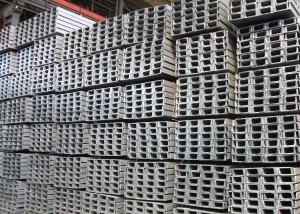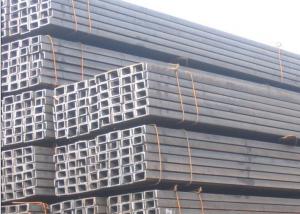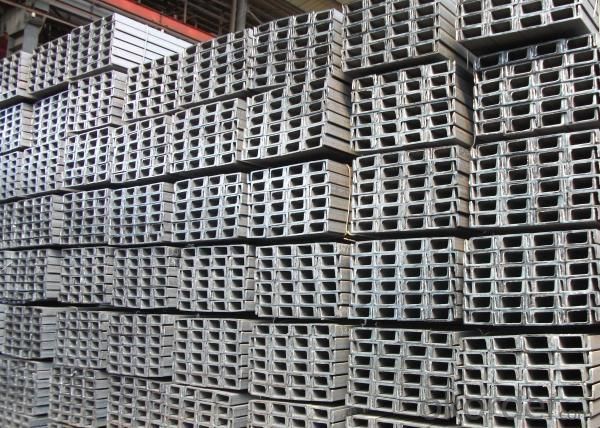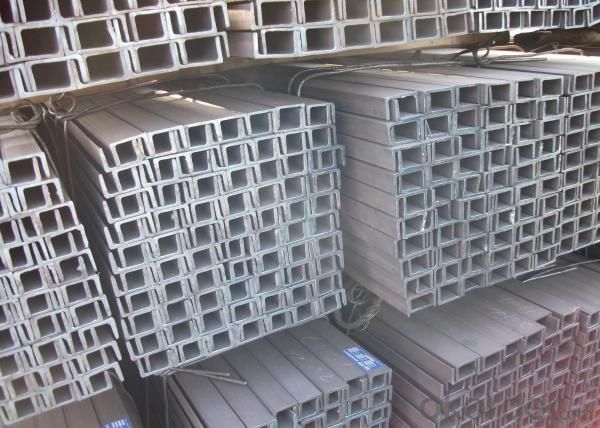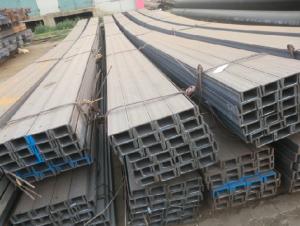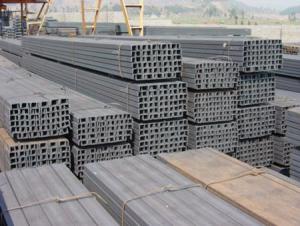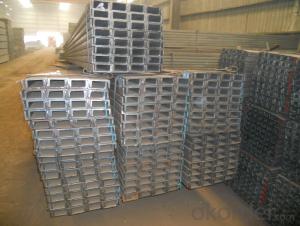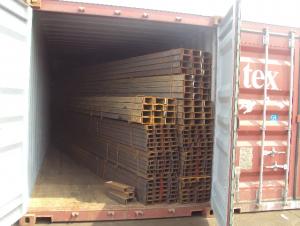Channel Steel
- Loading Port:
- Xingang Port
- Payment Terms:
- TT or LC
- Min Order Qty:
- 25 m.t.
- Supply Capability:
- 80000MTS/YEAR m.t./month
OKorder Service Pledge
OKorder Financial Service
You Might Also Like
Specifications of Channel Steel:
| Original Place | Tangshan, China | Brand Name | Bridge |
| Standard | GB707-88, EN100025, JIS G3192, DIN 1026 | ||
| Sizes | 50mm to 300mm | ||
| Sales Volume/Year | 3000MT | ||
| Main Market | Middle East, Africa, Southeast As | ||
1.We are able to provide channel steel of top quality at attractive price.
2.Our products of channel steel have passed ISO9001:2008 Quality Management System Certification.
3. The section of JIS Standard Channel Steel are as followings in the table.
| JIS U CHANNEL | Standard
h |
Sectional
b |
Dimension
s |
t |
Mass:
Kg/m |
| (mm) | (mm) | (mm) | (mm) | ||
| 50x25 | 50 | 25 | 3.0 | 6.00 | 2.37 |
| 75X40 | 75 | 40 | 3.8 | 7.00 | 5.30 |
| 75X40 | 75 | 40 | 4.0 | 7.00 | 5.60 |
| 75X40 | 75 | 40 | 4.5 | 7.00 | 5.85 |
| 75X40 | 75 | 40 | 5.0 | 7.00 | 6.92 |
| 100X50 | 100 | 50 | 3.8 | 6.00 | 7.30 |
| 100X50 | 100 | 50 | 4.2 | 6.00 | 8.03 |
| 100X50 | 100 | 50 | 4.5 | 7.50 | 8.97 |
| 100X50 | 100 | 50 | 5.0 | 7.50 | 9.36 |
| 125X65 | 125 | 65 | 5.2 | 6.80 | 11.66 |
| 125X65 | 125 | 65 | 5.3 | 6.80 | 12.17 |
| 125X65 | 125 | 65 | 5.5 | 8.00 | 12.91 |
| 125X65 | 125 | 65 | 6.0 | 8.00 | 13.40 |
| 150x75 | 150 | 75 | 5.5 | 7.30 | 14.66 |
| 150x75 | 150 | 75 | 5.7 | 10.00 | 16.71 |
| 150x75 | 150 | 75 | 6.0 | 10.00 | 17.90 |
| 150x75 | 150 | 75 | 6.5 | 10.00 | 18.60 |
4. Chemical Compostion of JIS Standard Channel Steel
| Grade | Element(%) | |||
| C | Mn | P | S | |
| SS330 | -- | -- | ≦0.050 | ≦0.050 |
| SS400 | ||||
| SS490 | ||||
| SS540 | ≦0.30 | ≦1.60 | ≦0.040 | ≦0.040 |
Usage/Applications of Channel Steel:
Channel Steel is usually used for building structure, vehicle manufacturing and other industrial structure and often used with i beam.
In details, the channel steel belongs to carbon structural steel which is applied to in the field of construction and machinery. The channel steel is usually used for arch-itechtural structure, and they could be welded in order to support or hang a vari-ety of facilities. They are also usually used in combination with I beam. Generally,the channel steel must possess perfect welding property, riveting property and mechanical property and so on.
Package & Delivery of Channel Steel:
The steel u channel will be packed in bundle with steel wire at each end of every bundle and color marking in order to help the customer to recognize his goods more easily at sight.
And steel u channel could be loaded into 20ft or 40ft container, or by bulk cargo. If the weight of each bundle reaches less than 3.5 mt, the loading by break bulk cargo should be choosed. When the weight of each bundle reaches less than 3mt, the loading by container should be choosed.
As for the transportaion from mill to loading port, the truck will be usually used. And the maximum quantity for each truck is 40mt.
All in all, we could do in accordance with customer's request.
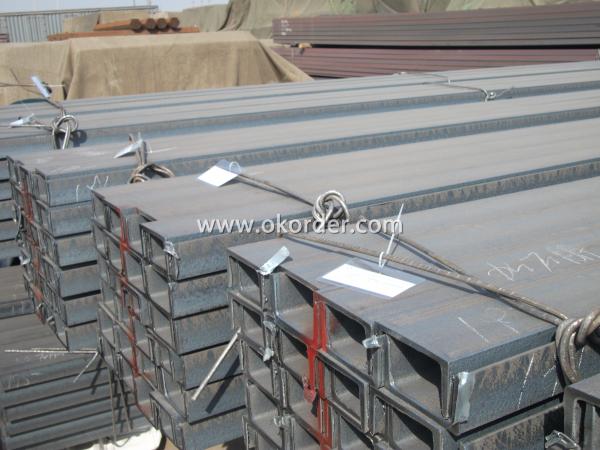
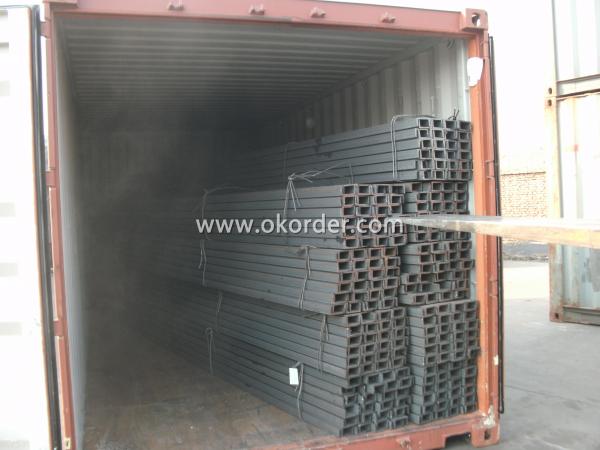
Production Flow of Channel Steel:
1.The steel billet shall be heated in the high temperature furnace.
2. The heated steel billet shall be rolled five to nine times with the aim of shaping the general figure of steel u channel.
3. The rolled steel u channel should be put onto the cooling bed to make the temperature low.
4. The steel u channel should be straighted on the straightener.
5. The straighted steel u channel will be cut into meters by saw, as per customer's requirements.
- Q: Are steel channels suitable for use in exhibition displays?
- Indeed, exhibition displays can indeed benefit from the use of steel channels. The selection of steel channels is often driven by their commendable sturdiness and resilience, which enables them to effectively support weighty display elements like panels, graphics, and signage. Moreover, steel channels possess the flexibility to be effortlessly tailored to suit diverse design prerequisites, thereby endowing exhibition displays with a sleek and contemporary appearance. Additionally, the ability to powder-coat or paint steel channels allows for seamless integration with the desired color scheme, thereby further elevating the overall aesthetic allure of the display. Nonetheless, it is crucial to carefully contemplate the specific demands of the exhibition, as well as the weight and dimensions of the materials to be showcased, in order to ensure that steel channels are indeed the most suitable option.
- Q: Can steel channels be used for bracing purposes?
- Yes, steel channels can be used for bracing purposes. Steel channels are commonly used in construction and engineering projects to provide structural support and reinforcement. They are often used as bracing elements to enhance the stability and strength of structures, such as buildings, bridges, and other load-bearing applications.
- Q: What are the different tolerances for steel channels?
- The steel channels' tolerances can differ depending on the specific standards and specifications set by the manufacturing industry or project requirements. Typically, the dimensions such as width, depth, and length are used to specify the tolerances for steel channels. For instance, the acceptable measurements for width and depth of steel channels are usually defined within a range. This range accounts for minor variations in channel dimensions, ensuring that it still meets the required specifications while allowing for manufacturing differences. To ensure the desired length requirements are met, the tolerance for steel channels' length can also be specified. This may include tolerances for both the overall length of the channel and any specific lengths needed for certain sections or cuts. In addition to dimensional tolerances, surface finish and straightness may also be specified. Surface finish tolerances determine the acceptable level of smoothness or roughness on the surface of the steel channel. Straightness tolerances define how much deviation from a straight line is acceptable for the channel. It is important to note that the tolerances for steel channels can vary depending on factors such as the industry, application, and the standards being followed. Therefore, it is always necessary to refer to the relevant standards or project specifications to determine the precise tolerances for a specific steel channel.
- Q: Are steel channels suitable for supporting overhead equipment or structures?
- Yes, steel channels are suitable for supporting overhead equipment or structures. Steel channels are often used in construction and engineering projects due to their strength and durability. They provide a stable and reliable support system for overhead equipment or structures, ensuring safety and stability. Steel channels are designed to withstand heavy loads, making them ideal for supporting equipment or structures that require a strong and sturdy foundation. Additionally, steel channels can be customized to meet specific project requirements, such as size, shape, and length, further enhancing their suitability for supporting overhead equipment or structures.
- Q: How do steel channels contribute to the overall sustainability of a solar power plant?
- Steel channels contribute to the overall sustainability of a solar power plant by providing structural support to the solar panels and helping maximize their efficiency. These channels are often made from recycled steel, reducing the need for new materials and minimizing the environmental impact. Additionally, steel channels are durable and long-lasting, ensuring the longevity of the solar power plant and reducing maintenance requirements.
- Q: Can steel channels be recycled?
- Yes, steel channels can be recycled. Steel is a highly recyclable material, and steel channels can be melted down and reprocessed to create new steel products without losing their structural integrity. Recycling steel channels helps conserve resources, reduce energy consumption, and minimize waste.
- Q: Can steel channels be used in stadium construction?
- Yes, steel channels can be used in stadium construction. Steel channels, also known as steel C-channels or U-channels, are commonly used in construction due to their strength, durability, and versatility. They are particularly useful in stadium construction as they can be used for a variety of purposes such as supporting structural elements, framing, creating architectural features, and providing additional strength to the overall structure. Steel channels are often used to create the framework for seating areas, walkways, and staircases in stadiums. Additionally, they can be used to support large screens, scoreboards, lighting fixtures, and other equipment necessary for stadium operations. The use of steel channels in stadium construction ensures a sturdy and reliable structure that can withstand the heavy loads and stresses that stadiums typically endure.
- Q: Are there any specific safety considerations when working with steel channels?
- Yes, there are specific safety considerations when working with steel channels. Some of these considerations include: 1. Personal protective equipment (PPE): It is essential to wear appropriate PPE when working with steel channels, such as safety goggles, gloves, steel-toed boots, and a hard hat. This helps protect against potential hazards such as flying debris, sharp edges, and falling objects. 2. Handling and lifting: Steel channels can be heavy and cumbersome, so it is important to use proper lifting techniques and equipment to prevent strain or injury. This may include using lifting straps, slings, or cranes to safely lift and move the channels. 3. Sharp edges and corners: Steel channels often have sharp edges and corners that can cause cuts or punctures. It is important to handle them with care and use appropriate tools, such as gloves, to avoid direct contact with these sharp areas. 4. Structural stability: When working with steel channels in construction or fabrication, it is crucial to ensure the structural stability of the setup. This includes properly securing the channels in place, using appropriate support systems, and following engineering specifications to prevent collapse or accidents. 5. Fire hazards: Steel channels are highly conductive and can quickly transfer heat, making them a potential fire hazard. It is important to take precautions to prevent sparks or open flames from coming into contact with the channels, especially in environments where flammable materials are present. 6. Slips, trips, and falls: Working with steel channels can involve working at heights or on elevated surfaces. It is important to maintain good housekeeping practices, such as keeping work areas clean and clear of obstructions, using proper ladder or scaffolding systems, and using fall protection equipment when necessary to prevent slips, trips, and falls. By considering these safety precautions and following best practices, the risk of accidents and injuries can be greatly reduced when working with steel channels.
- Q: What are the different methods of connecting steel channels?
- Connecting steel channels can be accomplished through various methods, each tailored to specific applications and structural needs. Some commonly employed techniques include: 1. Welding: Among the most popular methods, welding involves melting the metal at the joint and fusing it together. It results in a robust and permanent connection. Different welding techniques, such as arc welding, MIG welding, and TIG welding, can be utilized. 2. Bolting: By utilizing bolts, nuts, and washers, steel channels can be securely fastened. Holes are drilled in the channels, and bolts are inserted and tightened with nuts. This method allows for easy disassembly and reassembly, making it suitable for applications requiring frequent adjustments or modifications. 3. Riveting: Riveting, a traditional approach, involves using cylindrical metal pins called rivets to hold steel channels together. These rivets are inserted through pre-drilled holes and then hammered or pressed to secure them. This method ensures a sturdy and durable connection. 4. Adhesive bonding: This method employs industrial adhesives or epoxy resins to bond steel channels. It is particularly useful when aesthetics are important, as it leaves no visible fasteners. However, it may not be suitable for applications that require high load-bearing capacity. 5. Mechanical connectors: These connectors are specifically designed to link steel channels without the need for welding or drilling. They typically consist of clamps or brackets that can be secured to the channels using bolts or screws. Mechanical connectors provide a quick and efficient means of connection, enabling easy installation and disassembly. Ultimately, the choice of connection method depends on factors such as load-bearing requirements, structural design, ease of installation, and the need for adjustability or disassembly. It is recommended to consult with a structural engineer or a professional in the field to determine the most appropriate method for a specific application.
- Q: How do steel channels contribute to the durability of a structure?
- Steel channels contribute to the durability of a structure by providing structural support and reinforcement. They help distribute the weight and load of the structure evenly, reducing the risk of structural failure. Additionally, steel channels are highly resistant to corrosion, fire, and extreme weather conditions, which enhances the longevity and stability of the structure.
1. Manufacturer Overview
| Location | Hebei, China |
| Year Established | 1993 |
| Annual Output Value | Above US$100 Million |
| Main Markets | South Asia Middle East; Southeast Aisa; south Korea |
| Company Certifications | ISO 9001:2000 |
2. Manufacturer Certificates
| a) Certification Name | |
| Range | |
| Reference | |
| Validity Period |
3. Manufacturer Capability
| a) Trade Capacity | |
| Nearest Port | Tianjin; |
| Export Percentage | 1% - 10% |
| No.of Employees in Trade Department | 11-20 People |
| Language Spoken: | English; Chinese |
| b) Factory Information | |
| Factory Size: | Above 20,000 square meters |
| No. of Production Lines | 1 |
| Contract Manufacturing | OEM service offered |
| Product Price Range | average |
Send your message to us
Channel Steel
- Loading Port:
- Xingang Port
- Payment Terms:
- TT or LC
- Min Order Qty:
- 25 m.t.
- Supply Capability:
- 80000MTS/YEAR m.t./month
OKorder Service Pledge
OKorder Financial Service
Similar products
Hot products
Hot Searches
Related keywords
